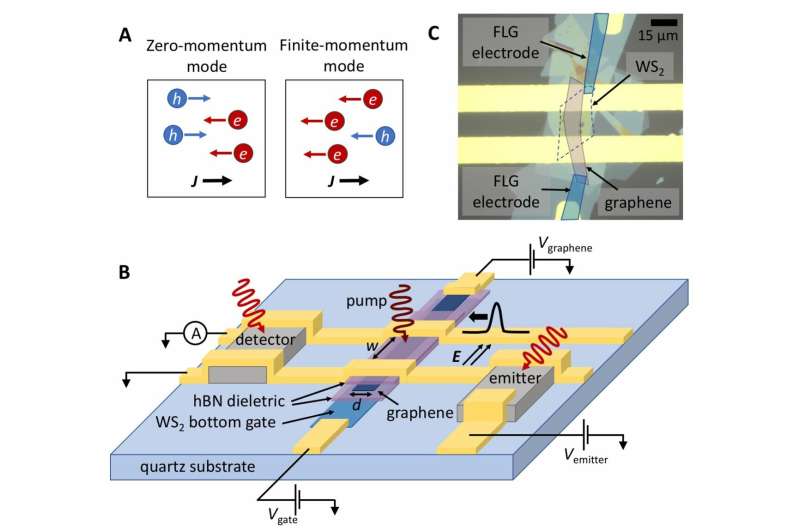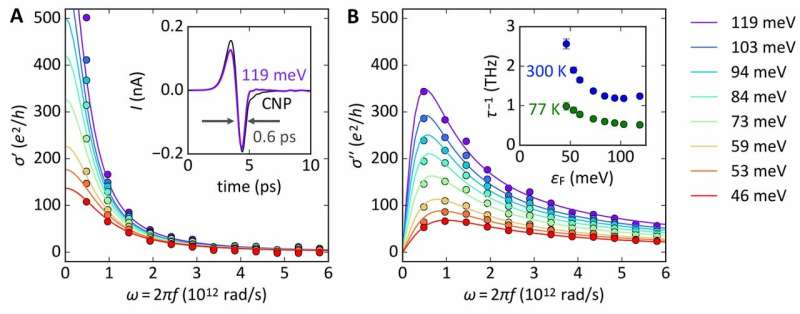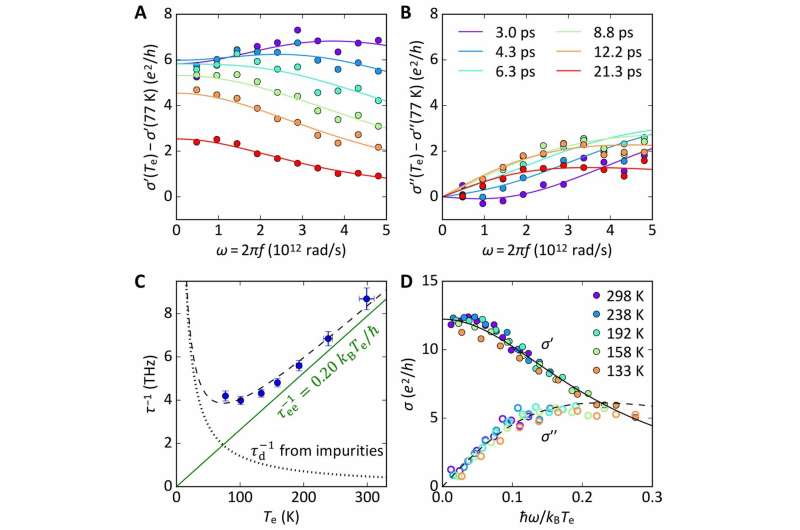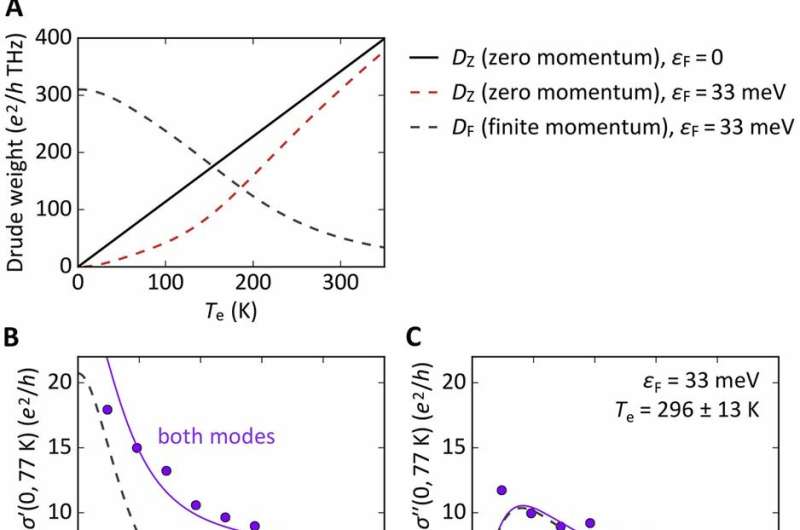March 13, 2019 feature
Quantum-critical conductivity of the Dirac fluid in graphene

Graphene is expected to behave like a quantum-critical, relativistic plasma known as "Dirac fluid" near charge neutrality in which massless electrons and holes rapidly collide. In a recent study now published in Science, Patrick Gallagher and co-workers at the departments of physics and materials science in the U.S., Taiwan, China and Japan used on-chip terahertz spectroscopy and measured the frequency-dependent optical conductivity of graphene between 77 K and 300 K electron temperatures for the first time. Additionally, the scientists observed the quantum-critical scattering rate characteristic of the Dirac fluid. At higher doping, Gallagher et al. uncovered two distinct current-carrying modes with zero and nonzero total momenta as a manifestation of relativistic hydrodynamics.
The work revealed the quantum criticality of the material in which each site is in a quantum superposition of order and disorder (similar to Schrödinger's hypothetical cat in a quantum superposition of 'dead' and 'alive') and the unusual dynamic excitation in graphene near charge neutrality. Physicists consider quantum relativistic effects in the experimental systems influencing condensed matter to be too minute for accurate description by the non-relativistic Schrödinger's equation. As a result, previous studies have reported on experimental condensed matter systems such as graphene (a single atomic layer of carbon) in which electron transport was governed by Dirac's (relativistic) equation.
Landau's theory of the Fermi liquid defines electron interactions of a typical metal as an ideal gas of non-interacting quasiparticles. In monolayer graphene, this description does not apply due to its structure of linearly dispersing bands and minimally screened Coulomb interactions. Near charge neutrality, graphene is thus expected to host a "Dirac fluid," which is a quantum-critical plasma of electrons and holes that are governed by relativistic hydrodynamics. In lightly doped graphene, a surprising consequence of relativistic hydrodynamics is that current can be carried by two distinct modes; with zero and non-zero total momenta, also referred to as "energy waves" and "plasmons" in some studies.

As doping increased, the weight of the zero-momentum mode was expected to decrease, while that of the finite-momentum mode increased to cross over smoothly from Dirac fluid to Fermi liquid behavior. Previous experiments on clean, monolayer graphene have demonstrated many-body physics in graphene, with examples including studies on low-frequency transport phenomena consistent with hydrodynamic descriptions. Additional experiments indicated violation of the Wiedemann-Franz law - as a signature of the Dirac fluid and as direct evidence of collective motion in a quantum electronic fluid, and the viscous flow of electrons. Even though electron-hole collisions have shown to limit conductivity in charge-neutral bilayer graphene, the direct observation of quantum-critical conductivity of the Dirac fluid has remained elusive.
Experimentally, time-domain terahertz spectroscopy is an ideal probe across a broad frequency range to observe quantum-critical conductivity, but use of the device is limited to lower-quality large-area films, within which Dirac fluid physics is obscured. In the present work, therefore, Gallagher et al. leveraged the subwavelength confinement of a coplanar waveguide to measure the terahertz optical conductivity of graphene, at ten-micron scale thickness ,encapsulated within hexagonal boron nitride (HBN). They used the experimental setup to measure the material's conductivity at electron temperatures (Te) ranging between 77 and 300 K to confirm the quantum-critical scattering rate near charge neutrality. The scientists also demonstrated the co-existence of zero- and finite-momentum modes at non-zero doping.

In the experimental setup, Gallagher et al. used photoconductive switches made of semiconducting materials with approximately one picosecond (ps) carrier lifetime to accomplish emission and detection of terahertz pulses. The emitter switch contacting the lower waveguide trace was biased with a dc voltage. When triggered by a laser pulse, the biased emitter became highly conductive for 1 ps. The process injected a current pulse into the coplanar waveguide to interact with graphene prior to reaching a detector switch spanning both traces. In practice, the scientists obtained lower noise by controlling the length of the optical path and detecting the current, to measure the time-domain profile of the transmitted voltage pulse (dV/dt).
After optimizing experimental conditions, the scientists first investigated the optical conductivity of the Fermi liquid at 77 K (T0). The transmitted waveforms contained sharp, sub-picosecond features that evolved with gate voltage to result in maximum transmission at charge neutrality. To extract the optical conductivity from the time-domain data and justify the finite-element simulations, the scientists modeled the device as an infinite, lossless transmission line. Gallagher et al. then probed transport at charge neutrality by observing the change in terahertz transmission (∆V) by optically heating the electron system from T0 = 77 K to varying electron temperatures (Te). To vary temperature in the experimental setup, they adjusted the delay between the optical pump and terahertz probe pulse.

In all measurements, the scientists heavily doped the graphene beneath the waveguide traces to minimize its impedance. The extracted scattering rates at 77 K were below 0.5 and 1 THz, indicating infrequent scattering by disorder and phonons, consistent with previous transport studies of similar doping; thus confirming the anticipated Fermi liquid behavior of graphene. The scientists probed the transport at charge neutrality by observing the change in terahertz transmission. For this, they optically heated the system and calculated the corresponding change in conductivity and the current carried in charge-neutral graphene under experimental conditions. The observed linear evolution in the experiments was a key signature of charge-carrier interactions in the quantum-critical Dirac fluid.

In this way, Gallagher et al. elegantly demonstrated the quantitative agreement between the experimental results and relativistic hydrodynamic theory of the Dirac fluid graphene. The scientists implied that graphene should host relativistic phenomena that are not observed in typical electron systems (to which relativistic hydrodynamics do not apply). For instance, in conventional metals, electronic sound waves either morph into plasmons or are destroyed by momentum relaxation. However, the new results indicate that such waves can exist in charge-neutral graphene as a result of low disorder and zero-coupling to plasmon modes. The experimental work by Gallagher et al. thus provided access to the subtle and rich physics of relativistic hydrodynamics of graphene in a bench top experiment. Further experiments can investigate the cyclotron resonance of graphene at high temperatures in the future.
More information: Patrick Gallagher et al. Quantum-critical conductivity of the Dirac fluid in graphene, Science (2019). DOI: 10.1126/science.aat8687
K. S. Novoselov et al. Two-dimensional gas of massless Dirac fermions in graphene, Nature (2005). DOI: 10.1038/nature04233
© 2019 Science X Network




















